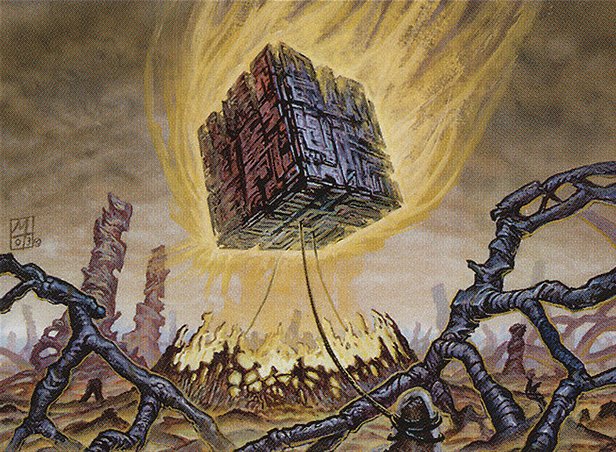 Art by Mark Tedin
Art by Mark TedinThis is an Historic-legal version of my original cube (iCube), with similar objectives:
- Don't be too overwhelming or difficult for new drafters. This cube in particular is limited to Historic (and err towards commons/uncommons) so it's playable on Arena for greater accessibility.
- Don't be too boring for current veteran players.
- Appeal to Johnny/Jenny: Every deck should feel like all the pieces click together!
A deeper dive into each rule is found below the archetypes.
Current Archetypes AvailableUW - Fliers
WB - Lifegain
BG - Escape
GR - Power 4+
RU - Non-Creature Spells
UB - Reanimator
BR - Sacrifice
RW - Equipped Tokens
WG - Enchantments
GU - Draw triggers & +1/+1 counters
Plus plenty of others like...
Ux cycling
RW cycling
Bx Reanimator
GW +1/+1 counters
...
#1 (N00bs) - This objective drives a lot of key decisions, like:
- Having clear archetypes with signpost guild cards. "Play fliers", "Play enchantments", or "Play instants & sorceries" helps newer drafters stick to a single plan and narrow down the cards they read (both in terms of color and "what says 'flying'?"). On a related note, try to avoid traps: for instance, since BW is the lifegain deck, if there were too many cards in green that gained life then newer players just scanning for "gain life" might drift towards a BG or WG lifegain deck that isn't really supported, even though for an expert that'd be fun crossover synergy.
- Keep the curve low and fixing plentiful. I've noticed inexperienced drafters don't often think about their curve or pick fixing very highly, so I keep the costs (including options like cycling) low enough that it's hard not to do something with a random hand of an average/bad deck. I've also increased the artifact count gradually so there's more colorless cards to smooth out the deck, and there's a lot of incidental fixing; although this can enable 5-color decks more often, there's so much synergy elsewhere that hopefully there isn't as much generic "good stuff" to abuse the abundant fixing.
- Bombs exist and look the part: Cavalier of Night, Shark Typhoon, Archon... these cards both look powerful, and ARE powerful, and also drive players towards certain colors or strategies (in contrast with signets, which look innocuous but are busted)
- Limit the number of keywords. This is less of a problem online (than in the original cube) where Arena can do some heavy lifting for you, but too many is still a lot to read while drafting. I've erred towards more recent mechanics, and nixing things like Fabricate and Flashback despite being technically legal.
- Track both "wall of text" cards, and those I think are complicated (either to understand or to assess once they're in play). They can be distinct, but I also want to make sure that each one pulls their weight (the "complicated" tag especially).
- Utilize Lenticular Design as much as possible (much harder with Historic's more limited card pool).
- Avoid traps & "WTF" cards. Prime Speaker Vannifar might be a lot of fun for vets, but doesn't at all reflect what UG is about, so it's a bad choice for what should be a "signpost" card.
- 360 Card limit - This helps curate the experience much more carefully, especially since replayability isn't as big an issue when targeting lapsed/newer players that will eventually graduate to other cubes.
#2 (Veterans) - I'm predisposed to up the complexity, so this one's not really a problem. Cycling does a lot of heavy lifting here, since it smooths out draws for a new player but provides tons of depth for vets that know how to abuse it. There's also plenty of fun build-arounds like Escape Protocol that provide good challenges to vets without totally derailing new players.
#3 (Johnny) - I want to maximize two feelings:
- The feeling of looking through a pack and thinking "OH! That card is PERFECT for my deck!" and not just because it fills out your curve. Healer's Hawk is a good example: "this is perfect for my [Lifegain/fliers/go-wide/enchantment] deck!" Or Hordeling Outburst, which feels great in RW go-wide, RU Spells, or RB sacrifice (vs. RG, where it's essentially just 3/3 for 3). If a card only really goes in one deck, it better be one of the clear signposts that drives the direction of the draft.
- The feeling in-game of "Yes, my deck is really doing its thing!" This usually means getting engines going, which can be dangerous if there aren't enough answers to engine pieces. However, too many answers and no one gets to do their thing. This is a delicate balance that will require testing, especially with such a radically reduced cardpool than the original, but I think we can get there.

